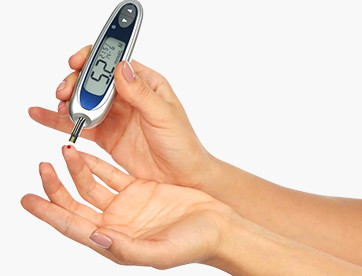Joined At The Hip: Diabetes, Obesity and Heart Disease
Category: Healthy Nutrition

Yep, that’s right! Heart disease, diabetes and obesity all go together! It is hard to talk about one without talking about the others.
First let me give you a few very alarming statistics: there is a world wide epidemic of diabetes – with an increase of 33% since 1990. And it is expected to double in the next 10 years. It used to be that Type II diabetes was an adult disease, affecting people in their 40’s and 50’s but today we are seeing diabetes in children – it is becoming a childhood disease, increasing even their risk for heart disease, high blood pressure, stroke, blindness, poor circulation resulting in amputations.

The American Heart Association lists obesity as a major risk factor for cardiovascular disease. Obesity quadruples the risk of high blood pressure, triglycerides and cholesterol.
Excess belly fat secrets inflammatory chemicals that damage arteries, leading to heart disease, clotting (stroke), vessel dysfunction, kidney disease and diabetes. Those with excess belly fat, especially around the middle, are 3 times more likely to get heart disease and diabetes than those who do not carry weight around the middle. Diabetes increases the risk of developing cardiovascular disease – heart attack and stroke. 75% of diabetics die of heart disease or stroke.
There are many connections between diabetes, obesity and heart disease. But let’s start with diabetes.
Diabetes is the leading cause of kidney disease, blindness, and amputations, yet nearly 25% of people who have it don’t even know it. In the United States 24 million people have been diagnosed with diabetes and the American Diabetes Association estimates that there are another 6 million who have the disease but don’t know it.
A very worrisome concern is that the death rate for diabetes has continued to grow since 1987. Chances are, you or someone you love has been affected by diabetes in some way. AND even if you haven’t been affected by diabetes, you need to know about diabetes and how you can reduce your risk of this epidemic illness.
What is Diabetes?
 Diabetes is a disease in which blood levels of simple sugar or glucose are elevated. This can be because of 2 reasons:
Diabetes is a disease in which blood levels of simple sugar or glucose are elevated. This can be because of 2 reasons:
1. because of inadequate insulin production in the pancreas or
2. from insulin resistance in the cells of the body, felt to be caused by obesity and an unhealthy diet. Elevated blood sugar levels are very damaging to your cells.
Symptoms? The major symptoms of diabetes are being very thirsty, being very hungry, frequent urination, unusual weight loss, unusual tiredness and blurry vision. Other symptoms can be muscle cramps, itching of the skin and poorly healing wounds.
There are four types of diabetes – type 1, gestational diabetes, pre-diabetes and type 2 diabetes
Type 1 diabetes, formerly called juvenile diabetes or insulin-dependent diabetes is usually first diagnosed in children, teenagers, or young adults. In this form of diabetes, the pancreas can no longer produce insulin and daily insulin administration is a lifelong reality.
Gestational diabetes usually develops in women who have an excessive weight gain during pregnancy. Although this type of diabetes usually goes away after childbirth, these women are at risk for developing type 2 diabetes later in life.
Pre-diabetes is a condition in which blood glucose levels are higher than normal but not high enough to be classified as diabetes. Pre-diabetes is estimated to affect as many as 57 million Americans, putting them at risk to develop type 2 diabetes, heart disease and stroke. Being overweight and physically inactive are contributing factors to both diabetes and pre-diabetes. In fact, about 80-90% of people with type 2 diabetes or pre-diabetes are overweight to obese.
Type 2 diabetes, formerly called adult-onset diabetes, is the most common form of diabetes. This is the one I want to focus on. Approximately 90% of all people with diabetes have type 2 diabetes. This form of diabetes usually begins with insulin resistance, a condition in which cells in fat, muscle and liver tissue do not use insulin properly. At first, the pancreas keeps up with the added demand by producing more insulin but over time the pancreas can no longer secrete enough insulin and blood sugar begins to rise.
Risk factors for developing diabetes include:
- Age – Increased prevalence with age, but it does occur in school aged children too. In the last 10 years childhood diabetes has doubled.
- Race – African Americans, Latinos, Native Americans, Asian Americans and Pacific Islanders seem to be a greater risk than other races.
- Family history of type 2 diabetes or a history of diabetes during pregnancy.
- Having other diseases such as hypertension, high triglycerides or poly-cystic ovarian syndrome.
- Obesity – A BMI of >25 and having an apple vs. pear body shape. It is interesting to note that in the last 10 years as diabetes has increased by 33%, obesity has also increased by 30%. People who are overweight and inactive are FAR more likely to develop type 2 diabetes. Over the years, people who continually have elevated blood glucose levels because they don’t control their calories and do not stay active will develop damage to blood vessels and nerves, increasing the risk for a number of serious, even life-threatening complications such as:
- Heart disease and stroke – Due to the narrowing of large arteries that supply the heart + increased risk of strokes + high cholesterol & triglycerides due to high sugar level in blood. Adults with diabetes have heart disease death rates about 2 to 4 times higher than adults without diabetes.
- Blindness – Narrowing and breakage of blood vessels in the eyes leads to blindness. Diabetic retinopathy causes 12,000 to 24,000 new cases of blindness each year making diabetes the leading cause of blindness in adults.
- Kidney disease – Due to high sugar in the urine. Diabetes is the leading cause of kidney failure and kidney failure is the cause of death for many diabetics.
- Neuropathy problems – Tingling, burning, numbness and pins and needles sensations especially in legs and feet.
- Peripheral Vascular Disease – Poor circulation to the legs and feet leading to gangrene and amputations. More than 60% of non-traumatic lower-limb amputations occur in people with diabetes.
- High blood pressure – Due to narrowing of the blood vessels.
- Infections – Diabetics are more prone to infections and often do not heal well.
- Depression – Because diabetes affects your nervous system.
All of that is the bad news so now let’s talk about the good news. Let’s switch gears and talk about the strategies for what to do to Reduce the Impact of Diabetes on Your Life!
 #1. Since obesity can affect insulin receptor sites, get weight under control.
#1. Since obesity can affect insulin receptor sites, get weight under control.
Because most people with diabetes and pre-diabetes are overweight to obese, the number ONE Strategy for improving blood glucose regulation is achieving a healthy weight. Studies have shown that people at risk for diabetes who lose weight and increase their physical activity level can prevent or delay diabetes and even return their blood sugar levels to normal.
Weight loss of 5-10% of your body weight can dramatically improve how your body uses insulin, can lower blood pressure, raise your good cholesterol and in one study reduced the development of diabetes by 58% over a 3 year period. The reduction was even greater (71%) for people over the age of 60!
High cholesterol, osteoarthritis, heart disease, stroke or cancer are all health conditions directly linked to being overweight and studies have shown modest weight loss can prevent or delay these conditions. Does being overweight prevent you from accomplishing what you want to do in life? Losing weight will ultimately help you feel and look better and increase your energy level so you can do more of the things you enjoy AND improve your total health!!
How can you keep the weight off?
- Eat a balanced diet full of good carbs – lots of vegetables and good protein. What we know is that is very important to always balance a carbohydrates with a protein, like an apple with 10 almonds.
- Eat a low fat diet.
- Don’t think of it as dieting but make it a way of life.
- Monitor your weight on a weekly basis so you can stay on top of it.
- Eat breakfast – do not skip this meal!
- Develop an exercise program.
#2. Boost your physical activity. Exercise removes glucose from the blood.
Increasing your level of physical activity not only increases calories burned in a day, it also improves insulin sensitivity – your body’s ability to use insulin to transport glucose from the blood into the cells of the body. Work towards getting 30 to 60 minutes a day of exercise most days of the week. Brisk walking is a great way to start and work in some light weight training which not only burns calories but stimulates muscle protein synthesis. It also helps to raise metabolism which helps in losing and maintaining weight.
#3. Don’t smoke! It causes constriction of arteries and it increases insulin resistance.
#4. Follow healthy eating principles. This is ESSENTIAL! Your diet should be balanced and rich in fresh fruits and vegetables, beans, whole grains, and lean protein foods like fish and white meat chicken. The American Heart Association also recommends soy as an excellent source of protein.
Eat monounsaturated fats like olive oil and peanut oil and omega 3’s in things like tuna and salmon. It’s important to cut back on foods that are high in saturated fat, trans fat (baked goods, cookies, pies, etc) and cholesterol. Fat blocks the natural action of insulin to utilize glucose as fuel for cells. The lower the fat intake, the better insulin works and the lower the blood sugar.
Avoid fast foods, soft drinks, things like sugared cereals, white flour pasta and fruit punch drinks (high fructose corn syrup) and cut down the use of the salt shaker. No white flour products Use 100% whole wheat bread and pastas. No white sugar (use stevia, fructose, or raw honey in moderation).
Boosting your intake of high quality protein and fiber at meal times also helps control hunger and makes you feel full, prevent fluctuations in blood sugar that can lead to feelings of low energy and food cravings.
Adequate amounts of dietary soluble fiber can also help lower cholesterol and blood sugar by slowing down the rate at which sugars enter the blood stream (Fiber One cereals are very good!)
#5. Take supplements to reduce or prevent the complications, as well as help prevent disease.
 Certain vitamins and minerals help support and regulate blood sugar. For example, chromium is needed for normal insulin function. Magnesium is also necessary for normal glucose metabolism by affecting both normal insulin secretion and responsiveness to insulin. Zinc is necessary for normal production, storage and secretion of insulin and vanadium is also involved in normal insulin function. Our pancreas is the organ in our body that makes insulin, so we need to support the pancreas with protein, vitamin C, B and zinc.
Certain vitamins and minerals help support and regulate blood sugar. For example, chromium is needed for normal insulin function. Magnesium is also necessary for normal glucose metabolism by affecting both normal insulin secretion and responsiveness to insulin. Zinc is necessary for normal production, storage and secretion of insulin and vanadium is also involved in normal insulin function. Our pancreas is the organ in our body that makes insulin, so we need to support the pancreas with protein, vitamin C, B and zinc.
Let’s talk about a suggested supplement program and how Shaklee products can help you prevent diabetes and help you manage it if you already have it.
- First of all, Shaklee’s 180 Turnaround program is designed to promote a safe rate of weight loss while helping to preserve your lean muscle mass by using the perfect balance of protein and carbohydrates and leucine, an amino acid that preserves muscle and helps burn body fat. Lean muscle burns more calories than non-muscle tissue! If you lose some of your muscle you lower your metabolism—which means you burn less calories and it is more difficult to lose weight. To help prevent lean muscle loss, get plenty of high quality protein and use the Shaklee 180 Life Shakes and/or meal bars with leucine as a great meal replacement.
- Glucose Regulation Complex or Metabolic Boost help retain normal blood sugar levels by promoting efficient glucose utilization. It helps to transport glucose into our cells, making our system more efficient, thereby promoting normal blood sugar levels. It also protects the integrity of cells so they can respond normally to insulin. It helps reduce blood sugar crashes that lead to low energy, hunger, and carbohydrate cravings.
- Vita-Lea is very helpful in making sure you are getting a good supply of vitamins and minerals. Generally, a well-balanced diet rich in vitamins and minerals is one of the most important factors in the control of diabetes. Vita Lea also helps to replace minerals lost during frequent urination. And it contains zinc which is essential for pancreas health and for immunity.
- The diabetic’s protein needs are higher than normal. Shaklee Life Shakes and Energizing Soy Protein are musts in this area because they provide good soy protein with balanced carbohydrates. A recent study showed that soy can reduce the amount of medication needed to lower blood sugar. They both have a perfect glycemic index – all well below 55.
- Fiber is extremely important because it slows down the conversion of carbohydrates to blood sugar. Shaklee has 2 different fiber products to choose from – Fiber Plan or Fiber Plan Tabs.
- Replace bad fats with good fatty acids like Shaklee Lecithin, which helps to balance insulin and heart healthy Shaklee Omega Guard. They also help with neuropathy symptoms and helps immunity. Omega’s help to reduce diabetic complications, lowers blood pressure and risk for stroke.
- Diabetics, especially those on insulin, lose vitamin C more easily so daily supplementation of vitamin C is necessary. Shaklee Vita-C Sustained Release is especially helpful for eye and kidney complications in the diabetic and is a natural infection fighter. It also prevents cataracts which diabetics are at greater risk for getting.
- B-Complex, especially biotin, Vitamin C, potassium, and protein help to stimulate insulin production in the body. Shaklee B-Complex helps to reduce neuropathy, reduces plaque formation in arteries, increases glucose use and increases immunity.
- And garlic because it lowers cholesterol, blood pressure and improves circulation.
With some lifestyle changes and strategically supplementing your daily eating habits, you can get your blood sugar under control.



Facebook Comments